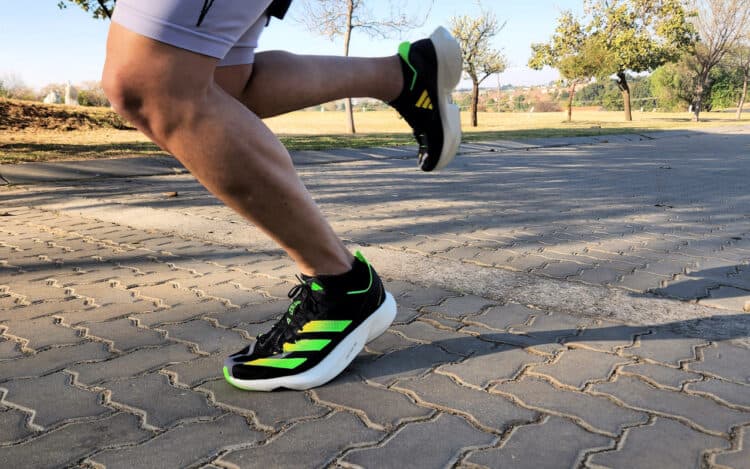When it comes to modern running shoes, there’s no limit on options to choose from. With so many differences in running styles, foot shapes, types of running and more, finding the perfect shoe is often a challenge. Wearing the correct shoe makes all the difference. This is especially true when it comes to running. With its latest release, adidas aims to take running to the next level. Having launched the adidas Adizero Adios Pro 3 a few weeks ago, I’ve been using it as my daily runner for quite some time now.
Having launched the original Adizero Adios Pro back in 2020, there has been quite a bit of change to the brand’s flagship running shoe. It’s not just skin deep, either. Adidas has focused a lot on the internals to make for a better running experience between the various iterations overall. With its second iteration, a few changes were made that negatively affected running performances for many pro athletes. As such, adidas went back to the drawing board to overhaul quite a bit of the shoe, from top to bottom.
Now, for its third iteration, it looks like a completely new line of shoes, with only the midsole design elements drawing on from the previous shoes. So, how does it fair compare to the original, and is it worth upgrading if you have either of the two previous iterations?
What’s New on the adidas Adizero Adios Pro 3?
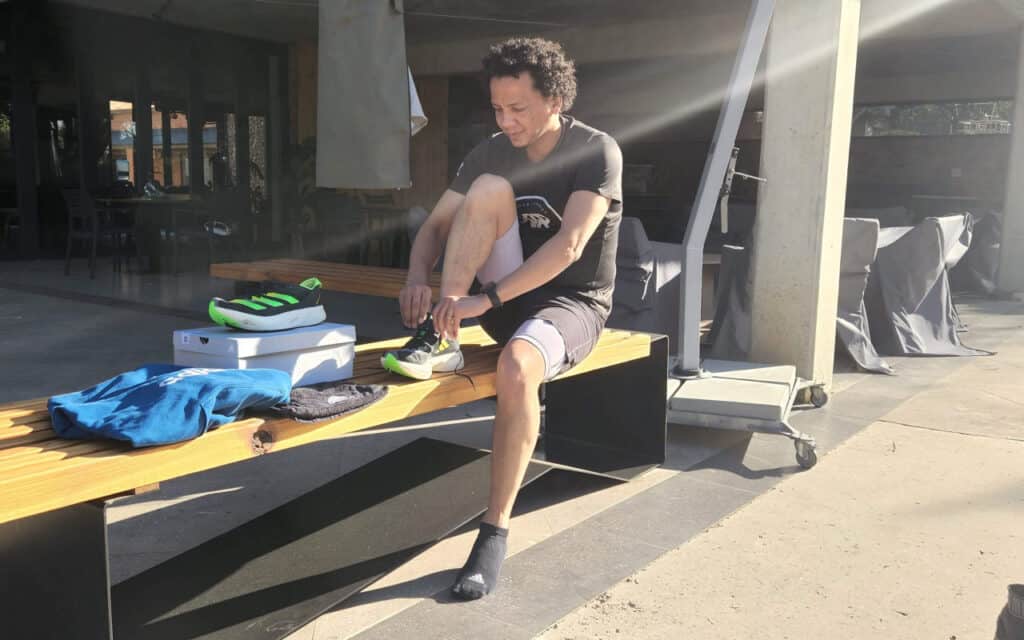
To say that there has been a plethora of changes in the adidas Adizero Adios 3 is an understatement. You’d think by this standard that it’s a completely new shoe. Well, it is, and it isn’t. It has been improved across all the various elements but still maintains the characteristics of the original and expands upon it. With that said, let’s take a look at all the changes made year-on-year.
For starters, what you’ll notice first is the upper. Besides the new theme for the shoe, there are some design and material changes. The shoe has also been crafted, in part, with recycled materials to reduce waste. The overall aim is to remove all virgin polyester, and this is one step towards that goal. More on the topic of the upper in the Design and Build section.
In terms of updating its performance, you have to look at its internals and how this was achieved. The first of these is the new ENERGYRODS 2.0. It features the same idea of carbon rods as the previous models. However, in the adidas Adizero Adios Pro 3, the rods are now a single structure to provide more stiffness underfoot and uniform energy return.
Surrounding the ENERGYRODS is the new Lightstrike Pro foam midsole. There are two levels within the foam, providing cushioning as well as adding to the energy return for greater support across longer-distance races.
Lastly, on the primary updates is the Continental rubber outsole. The first release of the Adizero Adios Pro didn’t include the branded rubber. Instead, it used an in-house rubber composite. It featured a flatter and smoother rubber outsole compared to the other Ultraboost running shoes. On the Adizero Adios Pro 3, the Continental rubber returns, although maintaining its smooth approach.
RELATED: adidas Originals Forum Exhibit Review
Design and Build
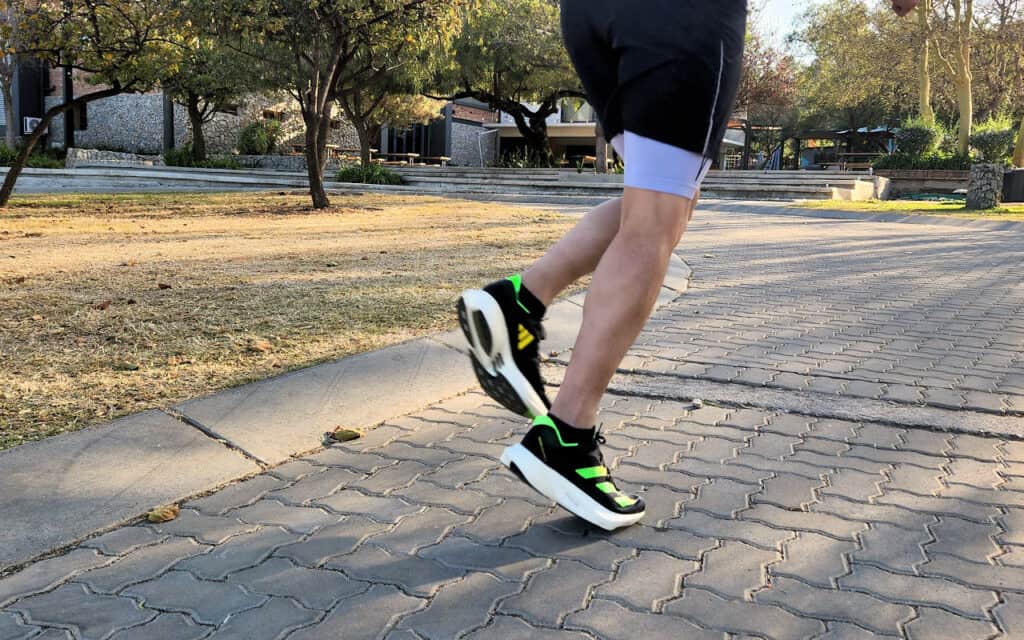
With my earlier statement that the adidas Adizero Adios Pro 3 is almost a completely new shoe, just a quick glance at it, and you’ll understand why. The upper has been completely revamped, and the midsole has been reworked for better performance on the road.
Starting with the upper, the new textile mesh finish looks completely different, even if you remove all the colouring, branding, etc. The previous Adizero Adios Pro 2 featured quite a significant amount of cutouts on the upper to allow for more weight reduction and breathability. However, it didn’t provide much in the way of support for runners. adidas has reverted to a more conventional CLERMESH material with a more comfortable fit.
The brand has gone for quite a different aesthetics as well on the new shoe. While the first iteration featured a decent helping of blue, pink, purple and orange, the second was more subdued in a white and red primary theme. Now, for the third installment, adidas has opted for a black upper with contrasting luminescent yellow and green touches. The midsole still features the same neutral white aesthetic and platform height comparisons.
What I found interesting about the concept is the contrast between the lateral and medial sides. The lateral sides feature more of a modernised approach with bold colours, fading lines and more, while on the medial side, it’s nothing but the adidas logo. The design is enhanced through cutouts on the midsole, which allows you to see its core with the ENERGYRODS skeleton. It may make for only a slight reduction in overall weight, but it definitely adds to the look.
Speaking of weight reduction, the runner is super light. For my UK9 variant, it weighs in at approximately 218g. For UK8, that’s 216g and 223g for UK10 sizes. Compared to the original, that’s a reduction of some 30g. It may not seem like a lot, but that’s around 10% reduced weight. And with every kilometre you eat up underfoot, it begins to add up over time.
While the overall aesthetic appears to be of the same family, the adidas Adizero Adios Pro 3 featured a rework across each of its visual elements. It will literally and figuratively leave you feeling taller from the moment you put them on your feet.
RELATED: adidas 4DFWD 2 Review – Chase Your Personal Best
New Generation Comfort
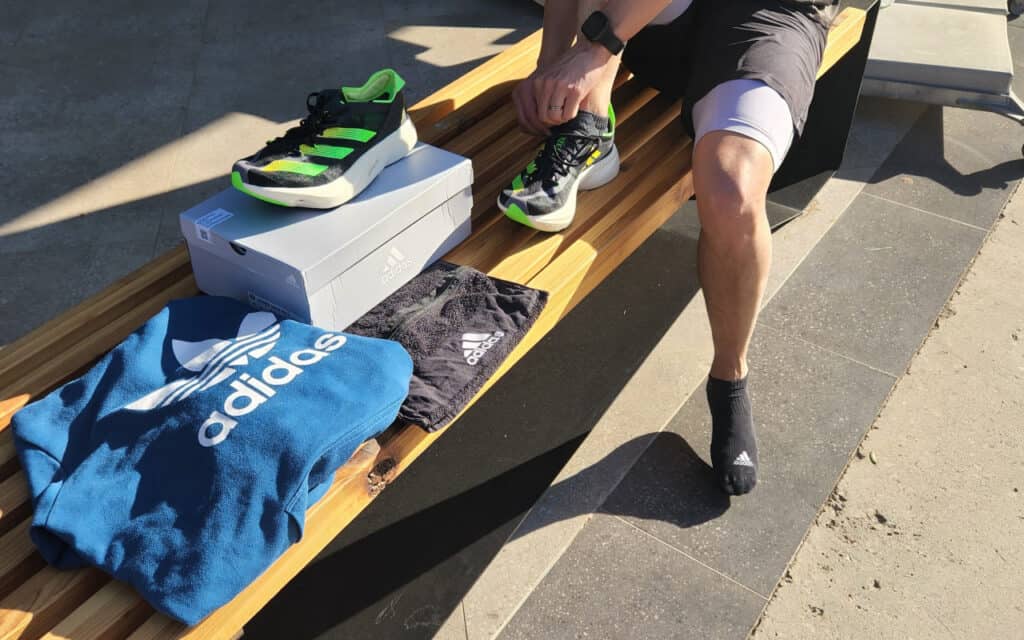
With a platformed midsole, there’s a high chance of comfort. But, not taking things for granted, there’s still a lot required to be consistent, especially when running.
When putting on the adidas Adizero Adios Pro for the first time, you’ll be able to feel the softness and bounciness of the midsole cushioning. It’s not as spongy as a few other running shoes I’ve experienced over the years, but it still feels very light in this regard.
For many running, this softness would be worrying. However, the added carbon-plated ENERGYRODS 2.0 provide the rigidity needed to keep some stiffness within your stride pattern. More on the overall impressions in the Performance section.
Other aspects of the shoe’s comfort come with the new cushioning, the mesh upper and the closed lacing system. The padding is apparent through the, most notably, around the ankle. Not only does it provide comfort around the ankle, but it also provides support in the form of locking in the foot for less slippage when in motion.
In terms of the mesh upper, it makes for the ultimate breathability. Even if you’re running in the winter, which we’ve just come out of, having cool feet while running long distances is essential. On the occasions I also ran with compression socks, they still offered the cooling effect so it didn’t overheat and become uncomfortable.
The shoe also offers quite a lot of room despite having a locked-down feel at the ankle. There is quite a lot of space to work with on the toe end of the shoe. For some, this may be a challenge, but I found it a lot more comfortable than the closely fitted shoes I’ve run with in the past. Having more room makes for a far better approach to marathon running versus a tighter fit when sprinting.
The Ultimate Performance
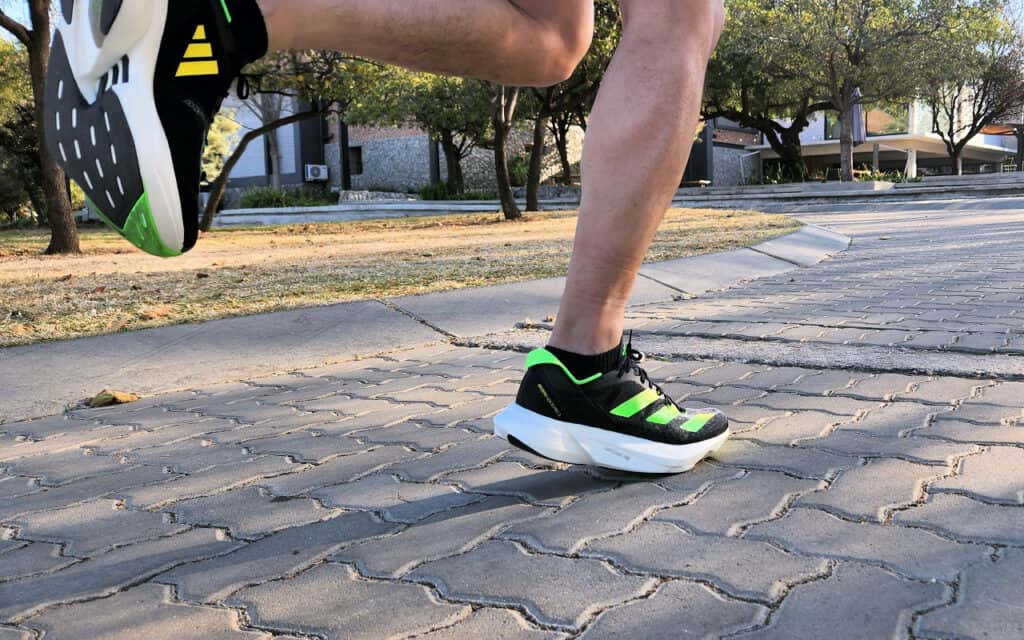
As with the rest of the Adizero range, the shoe was designed for performance. We’ve seen it deliver multiple records since the launch of the original adidas Adizero Adios Pro runner. And that has continued into the third iteration, with adidas announcing several new records in 2022 as a result of the improved shoe.
As with the other shoes before it, the most visible performance enhancement lies in the midsole. For starters, it’s a lot bouncier than previous versions. You can feel this simply by standing in place and forcing downwards without jumping. You can feel the bouncy rubber working in place.
When you’re out on the streets, however, this bouncy midsole is complimented by the ENERGYRODS 2.0 carbon plate. It works great in partnership as it doesn’t allow the Lightstrike midsole to squeeze all the way flat as a result of its softness. It adds stiffness to the ride while also producing its own energy return on the gait cycle on toe-off.
Staying on the midsole, it has quite a few notable points on the platform design. A lot of these specifications are in keeping with modern marathon regulations. Firstly, it has a 7mm heel, 6mm midfoot, and 4mm forefoot increase. The drop on the forefoot has been reduced to 6.5mm. This means that the overall heel is 39.5mm, with the forefoot measuring 33mm. This shows that it has more stack height over the Adizero Adios Pro 2 with a 39mm heel and 31.5mm forefoot, along with a 7.5mm drop. These new specifications on the thickness of the midsole are right on the extremities of what’s considered competition legal.
The Continental rubber is also far more grippy. When running on tar, asphalt or on the treadmill, you can almost feel that grip acting as propulsion when you toe off. It is immense. When you go off-road for a bit, there’s clearly less grip available, but it still does reasonably well despite the surface. I had one day I could test the grip out during a rainy day, and it still produces quite a lot of grip on the tar irrespective of the wetter surface.
Not all of the outsoles were designed to touch the surface when running. You’ll find quite a few cut-outs on the bottom of the shoe to reduce weight while also adding other elements that provide a lot more stability. It all works quite well together.
Overall, in terms of performance, the Adizero Adios Pro 3 is more aggressive in places while being more passive in other areas. The midsole is thicker for better cushioning and bounce, with the ENERGYRODS 2.0 giving you more energy return in each stride. However, with a reduced drop, you don’t get the same impact each time you hit the tar and on toe-off. For me, personally, this meant less strain on my legs overall, especially the ankles and the knees. It meant I could much more easily use the shoe as a daily driver compared to the previous iterations, where I had to limit the use due to the strain.
Further to this, the improved angles also mean that you don’t always need to go all out at pace for every run when wearing the shoe. I could adjust my running pace based on how I felt on the day or whether I was doing a recovery run. It feels more stable underfoot at either end of the scale, which is something that impressed me the most about the new approach.
RELATED: adidas X_PLRBOOST Review – Don’t Compromise on Comfort
Longevity and Quality
One of the big talking points about modern running shoes is their longevity. They may be quality products that produce outstanding results, but with all the mechanics at play, they can also bring a lot of wear and tear over the course of a few months’ worth of running.
For example, the individual carbon rods in the previous models were subjected to quite a lot of pressure. This was exacerbated as a result of the individual rods where pressure isn’t evened out. It then meant that the odd rod would fracture after a few months of running, especially as a daily driver.
With the ENERGYRODS 2.0’s single plate finish, it makes for a much better distribution of the pressure coming down on each stride. This increases the longevity of the product overall.
Further to this, the high-angled stack of the midsole meant that certain aspects of it would be exposed to a lot more wear than the rest. None was more prevalent than the toe area on the outsole as a result of the pronounced toe-off. We’ve seen plenty of wear in that area on the previous models, making it unusable as a result.
This time around, and with the Continental Rubber partnership, this portion was redesigned. While the rest of the outsole features a smoother finish, this area has a much thicker rubber finish. It is distinguished as well from the rest of the black rubber with a green finish to indicate the difference. It makes for a longer-lasting shoe in an area that was affected quite significantly before.
While the performance is the ultimate goal, and where it succeeds, the improvements in the quality resulting in a longer-lasting running shoe is a very welcome enhancement.
RELATED: adidas 4DFWD 2 Review – Chase Your Personal Best
Should You Buy the adidas Adizero Adios Pro 3?
Oftentimes, I wonder how much better a product, like a running shoe, can be improved each year. With technology items, you can do this by adding more hardware specifications. However, in the case of the adidas Adizero Adios Pro 3, the answer isn’t adding more to it. Instead, you reduce the weight, tweak the design, enhance the energy return, increase the comfort and change the dynamic of the midsole for a more rounded experience. It’s not a completely new shoe, but it has all the hallmarks of a finely tuned F1 car over the race weekend to hit the sweet spot for the best race possible.
The running shoe won’t fit every budget. Yes, it’s geared towards the more serious runners among us, but that doesn’t mean to say it won’t offer a truly great experience for anyone owning a pair. That being said, it is more affordable than the previous edition. Having hit some personal bests in 2022 as a result of the shoe, I can not deny its potential. It’s a great shoe and, with great improvements, makes for impressive results across the board.
The Review
Adizero Adios Pro 3
With each new iteration, adidas pushes towards the ultimate running shoe. The adidas Adizero Adios Pro 3 is the best shoe I've run with. While the previous iterations were fast, the new shoe is both fast and a lot more comfortable and stable for daily runs.
PROS
- Still crunching those Personal Bests
- Wear and tear regions have been bolstered
- Reduced weight
- More midsole cushioning
- ENERGYRODS 2.0
CONS
- Short laces require a clamp
- Can be too roomy for some


